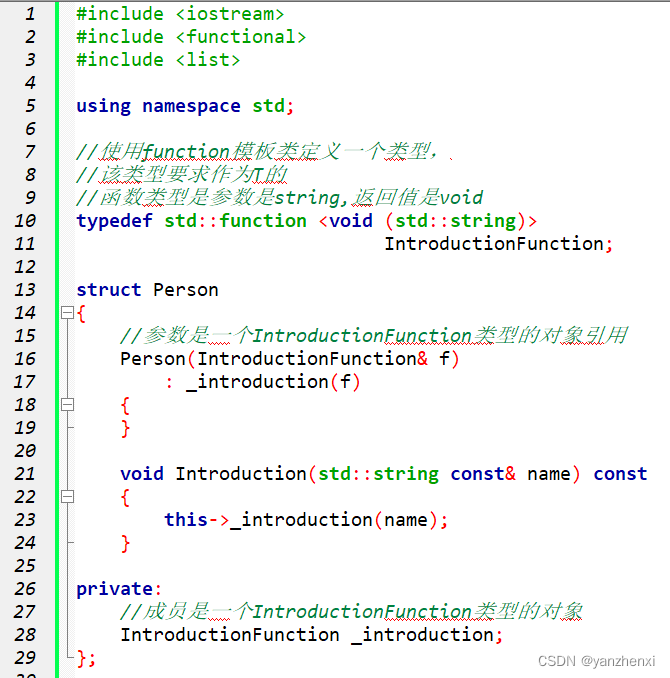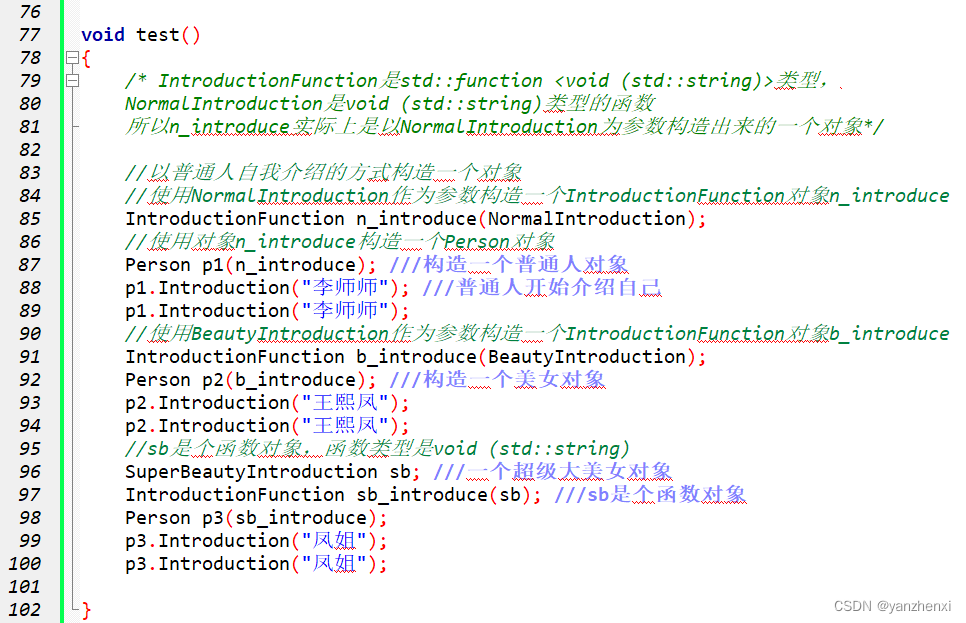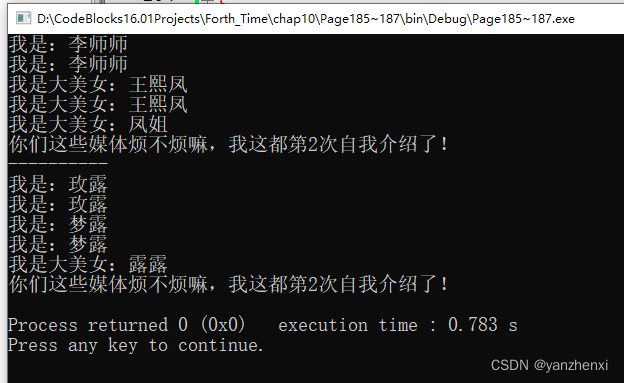10.9.2 std::function 非OO的多态实现 Page185~187
发布时间:2024年01月15日






源代码:
#include <iostream>
#include <functional>
#include <list>
using namespace std;
//使用function模板类定义一个类型,
//该类型要求作为T的
//函数类型是参数是string,返回值是void
typedef std::function <void (std::string)>
IntroductionFunction;
struct Person
{
//参数是一个IntroductionFunction类型的对象引用
Person(IntroductionFunction& f)
: _introduction(f)
{
}
void Introduction(std::string const& name) const
{
this->_introduction(name);
}
private:
//成员是一个IntroductionFunction类型的对象
IntroductionFunction _introduction;
};
//普通人的介绍
//函数类型是参数是string,返回值是void,
//可用来构造IntroductionFunction类型的对象
void NormalIntroduction(std::string const& name)
{
cout << "我是:" << name << endl;
}
//美女的介绍
//参数是string,返回值是void,
//可用来构造IntroductionFunction类型的对象
void BeautyIntroduction(std::string const& name)
{
cout << "我是大美女:" << name << endl;
}
///超级大美女的介绍
struct SuperBeautyIntroduction
{
SuperBeautyIntroduction()
: _count(0)
{
}
//重载(),参数是string,这样SuperBeautyIntroduction的对象
//可以作为函数对象使用,函数类型是void (std::string),
//所以SuperBeautyIntroduction的对象也可以用来构造
//IntroductionFunction对象
void operator () (std::string const& name)
{
if(_count < 1)
{
BeautyIntroduction(name);
}
else
{
cout << "你们这些媒体烦不烦嘛,我这都第"
<< _count + 1 << "次自我介绍了!" << endl;
}
++ _count;
}
private:
int _count;//介绍次数
};
void test()
{
/* IntroductionFunction是std::function <void (std::string)>类型,
NormalIntroduction是void (std::string)类型的函数
所以n_introduce实际上是以NormalIntroduction为参数构造出来的一个对象*/
//以普通人自我介绍的方式构造一个对象
//使用NormalIntroduction作为参数构造一个IntroductionFunction对象n_introduce
IntroductionFunction n_introduce(NormalIntroduction);
//使用对象n_introduce构造一个Person对象
Person p1(n_introduce); ///构造一个普通人对象
p1.Introduction("李师师"); ///普通人开始介绍自己
p1.Introduction("李师师");
//使用BeautyIntroduction作为参数构造一个IntroductionFunction对象b_introduce
IntroductionFunction b_introduce(BeautyIntroduction);
Person p2(b_introduce); ///构造一个美女对象
p2.Introduction("王熙凤");
p2.Introduction("王熙凤");
//sb是个函数对象,函数类型是void (std::string)
SuperBeautyIntroduction sb; ///一个超级大美女对象
IntroductionFunction sb_introduce(sb); ///sb是个函数对象
Person p3(sb_introduce);
p3.Introduction("凤姐");
p3.Introduction("凤姐");
}
void demo_polymorphism_without_virtual()
{
//list的元素类型是pair <Person, string>
std::list <std::pair <Person, std::string>> lst;
/**< IntroductionFunction的参数是string类型,返回值是void类型 */
/**< IntroductionFunction是Person类的一个成员 */
//n_introduce是个IntroductionFunction类型的函数
/**< 相当于IntroductionFunction n_introduce = NormalIntroduction */
IntroductionFunction n_introduce(NormalIntroduction);
/**< 相当于IntroductionFunction b_introduce = BeautyIntroduction; */
IntroductionFunction b_introduce(BeautyIntroduction);
SuperBeautyIntroduction sb; //一个超级大美女对象
IntroductionFunction sb_introduce(sb); ///这里不用ref, 这里的sb是函数对象sb()
/**< 将Person和名字绑定到一起构成一个pair,然后存储到lst里面 */
lst.push_back(std::make_pair(Person(n_introduce), "玫露"));
lst.push_back(std::make_pair(Person(n_introduce), "梦露"));
lst.push_back(std::make_pair(Person(sb_introduce), "露露"));
for(auto it = lst.begin(); it != lst.end(); ++ it)
{
//每人自我介绍两次:
it->first.Introduction(it->second);
it->first.Introduction(it->second);
}
}
int main()
{
test();
cout << "----------" << endl;
demo_polymorphism_without_virtual();
return 0;
}
文章来源:https://blog.csdn.net/yanzhenxi/article/details/135591645
本文来自互联网用户投稿,该文观点仅代表作者本人,不代表本站立场。本站仅提供信息存储空间服务,不拥有所有权,不承担相关法律责任。 如若内容造成侵权/违法违规/事实不符,请联系我的编程经验分享网邮箱:chenni525@qq.com进行投诉反馈,一经查实,立即删除!
本文来自互联网用户投稿,该文观点仅代表作者本人,不代表本站立场。本站仅提供信息存储空间服务,不拥有所有权,不承担相关法律责任。 如若内容造成侵权/违法违规/事实不符,请联系我的编程经验分享网邮箱:chenni525@qq.com进行投诉反馈,一经查实,立即删除!
最新文章